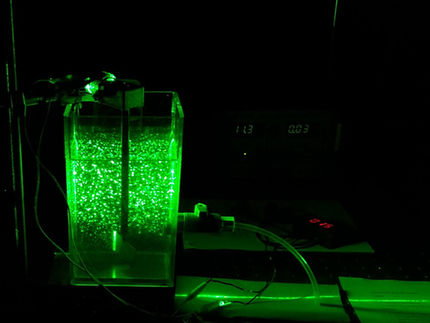Ames Laboratory scientists crack long-standing chemistry mystery
A team of researchers at the U.S. Department of Energy's (DOE's) Ames Laboratory has answered a key question concerning the widely-used Fenton Reaction – important in wastewater treatment to destroy hazardous organic chemicals and decontaminate bacterial pathogens and in industrial chemical production. The naturally occurring reaction was first discovered in 1894 by H.J.H. Fenton, a British chemist at Cambridge, and involves hydrogen peroxide (H2O2) and iron.
How the Fenton reaction actually happens has remained in contention. Scientists have long debated whether it was a hydroxyl (OH) radical or a form of iron known as the ferryl ion, [Fe(IV)O]2+, that functioned as the reaction intermediate for the Fenton reaction, with data to support both theories.
Now, Andreja Bakac and Oleg Pestovsky, scientists at Ames Laboratory in the Division of Chemical and Biological Sciences, and chemistry graduate student Hajem Bataineh, have proved that the reaction can take different paths depending on the pH of the reaction environment. In an acidic environment, the intermediate is an OH radical; at neutral pH, the intermediate is the ferryl ion.
"This is enormous when you think about all the work that went into trying to solve this issue when the acidity of the solution was not considered as a parameter. It certainly varied from one work to the next, and may explain the confusion that grew out of contradicting results in the literature," said Bakac.
So, is the reaction fundamental? Yes. Simple? No. The exact nature of the mechanism of the Fenton reaction has eluded science for decades, and has been all that time a subject of close inquiry—and debate.
"The reaction takes place between iron which is widespread on Earth, and hydrogen peroxide which is derived from oxygen and also present almost everywhere on this planet. You know you are facing a real challenge when the reaction between two very common compounds has not been fully explained in a hundred years, despite all the efforts," said Bakac.
Over those past hundred years, the Fenton intermediates were reduced to two, the hydroxyl radical or the ferryl ion.
Much was known already about hydroxyl radicals. However, it wasn't until 2005 that Bakac's research group, in collaboration with groups at Carnegie Mellon and University of Minnesota, was able to directly characterize the ferryl ion and study its reactions. This gave them the ability to compare the two potential intermediates.
"We found that these two species, in many of the reactions, behave pretty much the same, which would make it very difficult to distinguish between them," explained Bakac of the earlier research. "The breakthrough came with some unique reactions that one intermediate will do and the other one will not, or where the products were different, and that gave us the key.
"We were thrilled to obtain a clear and unambiguous answer. The intermediate was the OH radical, and not the ferryl ion. We published the paper, we had a write up in Chemical and Engineering News; this was very exciting."
But the question still didn't seem settled. Other scientists continued to assert that ferryl was the intermediate.
"We thought how can this be? We just proved that it isn't. There were also some theoretical papers that came out at the time, also supporting the ferryl ion."
The continued debate prompted Bakac and her research partners to look at the potential effect of reaction conditions, specifically the acidity of the solution. That led to the discovery that either intermediate can be involved, depending on the pH of the reaction environment.
The discovery not only solves a long-running debate in academic chemistry, it opens up possibilities for new ways to use the reaction.
"If we can understand fully what's going on, then we can take advantage of that understanding and develop new uses for the Fenton reaction," said Bakac. The discovery could lead to catalytic reactions using widely available iron in neutral conditions, and environmentally friendlier processes in everything from wastewater treatment to industrial oxidations.
"It becomes not just a better understood reaction, but a more useful one from a practical standpoint," said Bakac.






























































